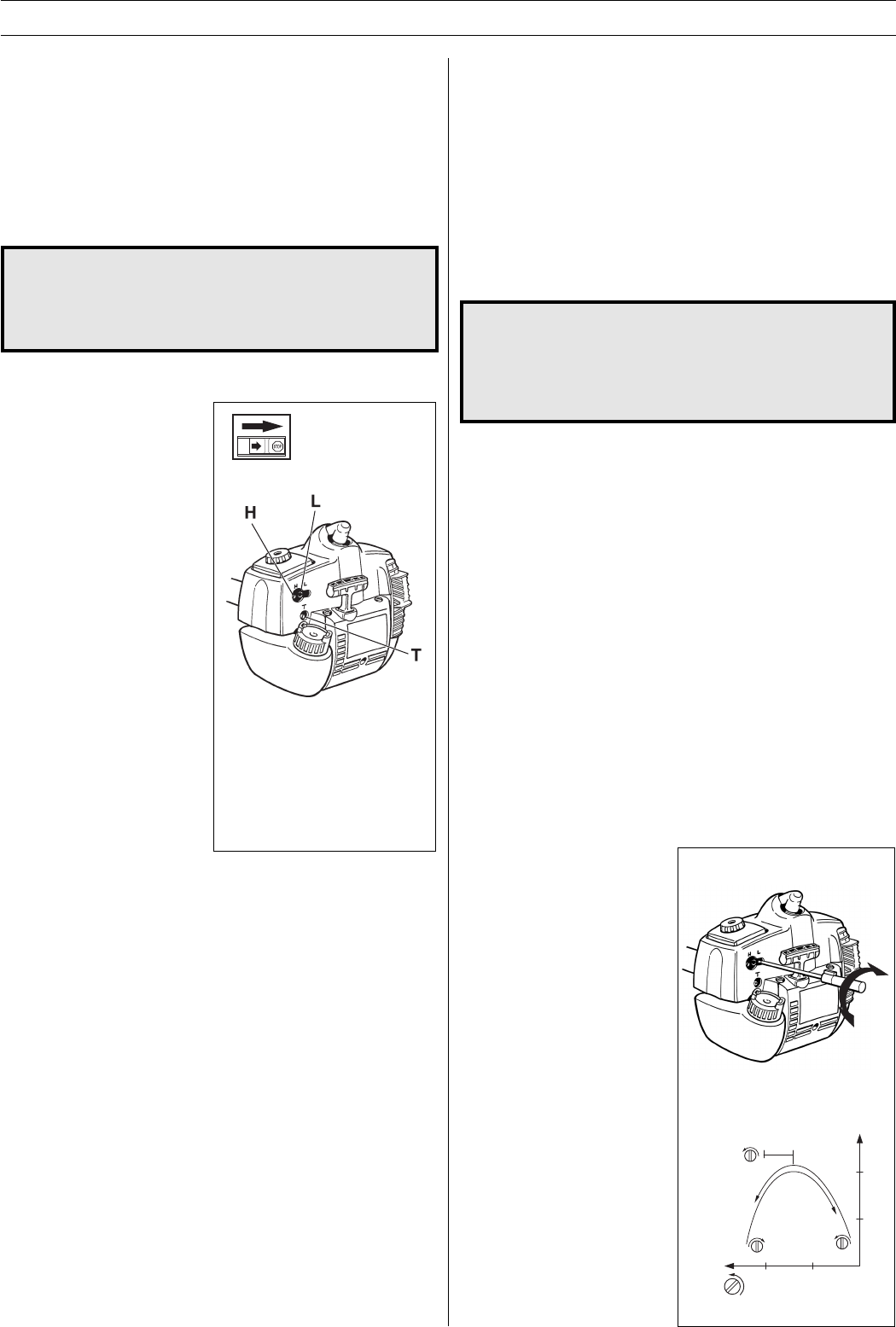
16 – English
Carburettor
Your Husqvarna product has been designed and manufactured
to specifi cations that reduce harmful emissions.
After your unit has been run 8-10 tanks of fuel the engine has
broken in. To ensure that your unit is at peak performance and
producing the least amount of harmful emissions after break
in, have your authorized servicing dealer, who has a revolution
counter at his disposal, to adjust your carburettor for optimum
operating conditions.
Basic setting
• The carburettor is set to its basic setting when test run at the
factory. The basic setting is richer than the optimal setting
and should be kept during the machineʼs fi rst working hours.
Thereafter the carburettor should be fi nely adjusted. Fine
adjustment should be carried out by a skilled technician.
NOTE! If the blade rotates while the engine is idling the T screw
should be turned anticlockwise until the cutting attachment
stops.
Rec. idling speed: 2 700 rpm.
Rec. max speed: See ”Technical data”.
!
WARNING!
The complete clutch cover with shaft must
be fi tted before the machine is started,
otherwise the clutch can become loose and
cause personal injury.
Operation
• The carburettor governs
the engineʼs speed via the
throttle. Air/fuel is mixed in
the carburettor. The air/fuel
mixture is adjustable. To
take advantage of the
engineʼs optimal output the
adjustment must be correct.
• The setting of the
carburettor means that the
engine is adapted to local
conditions, for example, the
climate, altitude, petrol and
the type of 2-stroke oil.
• The carburettor is equipped
with three adjustment
possibilities:
L = Low speed needle
H = High speed needle
T = Idle speed adjuster
screw
• The fuel quantity in relation to the air fl ow permitted by the
throttle opening is adjusted using the L and H-needles.
Turning the needles clockwise gives a leaner fuel mixture
(less fuel) and turning them anticlockwise gives a richer fuel
mixture (more fuel). A leaner mixture gives high revs while a
richer mixture give less revs.
• The T-screw regulates the position of the throttle while the
engine is idling. Turning the screw clockwise gives a higher
idling speed while turning it anticlockwise gives a lower idling
speed.
!
WARNING!
If the idling speed cannot be adjusted so
that the cutting attachment stops, contact
your service workshop. Do not use the
machine until it has been correctly adjusted
or repaired.
Fine adjustment
• When the machine has been ”run-in” the carburettor should
be fi nely adjusted. The fi ne adjustment should be carried
out by qualifi ed person. First adjust the L-jet, then the idling
screw T and then the H-jet.
Conditions
• Before any adjustments are made the air fi lter should be clean
and the air fi lter cover fi tted. Adjusting the carburettor while a
dirty air fi lter is in use will result in a leaner mixture when the
fi lter is fi nally cleaned. This can give rise to serious engine
damage.
• Turn the L and H needles carefully to the middle point
between fully screwed in and fully screwed out.
• Do not attempt to adjust the needles beyond the stops as
damage can occur.
• Now start the machine as set out in the start instructions and
run it warm for 10 minutes.
NOTE! If the cutting equipment rotates/moves while idling
the T screw should be turned anticlockwise until the cutting
equipment stops.
Low speed needle L
Try to fi nd the highest idling
speed, turning the low
speed needle L clockwise
respectively counter-
clockwise. When the highest
speed has been found, turn
the low speed needle L 1/4
turn counter-clockwise.
NOTE! If the cutting
attachment rotates/moves in
the idling position, turn the
idling speed screw T counter-
clockwise until the cutting
attachment stops.
MAINTENANCE


















